Sutton Place, Burpham: Difference between revisions
Created page with "{{Infobox house |name=Sutton Place |county=Surrey |picture=Entrance facade at Sutton Place - geograph.org.uk - 1556942.jpg |picture caption=Entrance facade at Sutton Place |os..." |
No edit summary |
||
| Line 42: | Line 42: | ||
==Terracotta elements== | ==Terracotta elements== | ||
[[File:SuttonAmorini1.jpg|left|thumb| | [[File:SuttonAmorini1.jpg|left|thumb|170px|Terracotta ''amorini'' above entrance door, detail from 1840 illustration by Nash]] | ||
The decorative elements made from moulded [[terracotta]] on the facade are renaissance italianate. They consist of designs made from 40-50 different moulds,<ref name=har>Harrison, pp.161–2</ref> most strikingly comprising a panel of two rows of ''amorini'' immediately above the entrance door. Such Italianate influence had never before been seen in English architecture, and is thought to have resulted from designs seen by Weston during his travels on embassies to France, where he might have seen some of the newly built chateaux on the Loire. With very minor exceptions, no stone was used in the building and decoration of Sutton Place, only brick and terracotta.<ref>Harrison, p.153. Exceptions include stone tops of semi-octagonal turrets flanking the main entrance door (p.162, note 1)</ref> Thus, the bases, doorways, windows, string-courses, labels and other dripstones, parapet, angles, cornices, and finials are all of moulded clay.<ref name=har/> Such usage is only found in two other contemporary buildings, [[East Barsham Manor]] in Norfolk and [[Layer Marney Tower]] in Essex. Its use was, however, rapidly abandoned in England, to appear again only in the Victorian era. The terracotta proved very hard-wearing and was described by Harrison in 1899 as "sharp and perfect" in condition.<ref name=har/> The terracotta has, however, undergone, in the 1980s, a £12 million refurbishment, involving much replacement, by the specialist firm Hathernware Ceramics Ltd, which used 18 different colour blends of clay to match the original variety of shades.<ref>[http://www.hathernware.co.uk/projects/sutton_place.htm Hathernware Ceramics Ltd — terracotta restorer here in the 1980s]</ref> Prior to that, it seems the only new elements were from 1875 when 10 new terracotta mullions and window-frames made by Messrs Blashfield of Stamford, from moulds of existing windows, replaced sash-windows inserted in the 18th century. Two completely new small windows were, at the same time, created from terracotta in the gables of the quadrangle.<ref>Harrison, pp.162-3</ref> | The decorative elements made from moulded [[terracotta]] on the facade are renaissance italianate. They consist of designs made from 40-50 different moulds,<ref name=har>Harrison, pp.161–2</ref> most strikingly comprising a panel of two rows of ''amorini'' immediately above the entrance door. Such Italianate influence had never before been seen in English architecture, and is thought to have resulted from designs seen by Weston during his travels on embassies to France, where he might have seen some of the newly built chateaux on the Loire. With very minor exceptions, no stone was used in the building and decoration of Sutton Place, only brick and terracotta.<ref>Harrison, p.153. Exceptions include stone tops of semi-octagonal turrets flanking the main entrance door (p.162, note 1)</ref> Thus, the bases, doorways, windows, string-courses, labels and other dripstones, parapet, angles, cornices, and finials are all of moulded clay.<ref name=har/> Such usage is only found in two other contemporary buildings, [[East Barsham Manor]] in Norfolk and [[Layer Marney Tower]] in Essex. Its use was, however, rapidly abandoned in England, to appear again only in the Victorian era. The terracotta proved very hard-wearing and was described by Harrison in 1899 as "sharp and perfect" in condition.<ref name=har/> The terracotta has, however, undergone, in the 1980s, a £12 million refurbishment, involving much replacement, by the specialist firm Hathernware Ceramics Ltd, which used 18 different colour blends of clay to match the original variety of shades.<ref>[http://www.hathernware.co.uk/projects/sutton_place.htm Hathernware Ceramics Ltd — terracotta restorer here in the 1980s]</ref> Prior to that, it seems the only new elements were from 1875 when 10 new terracotta mullions and window-frames made by Messrs Blashfield of Stamford, from moulds of existing windows, replaced sash-windows inserted in the 18th century. Two completely new small windows were, at the same time, created from terracotta in the gables of the quadrangle.<ref>Harrison, pp.162-3</ref> | ||
[[File:SuttonSingleTun.jpg|right|thumb|180px|Rebus of Weston, a "waisted-tun"]] | |||
[[File:SuttonSingleTun.jpg|right|thumb| | |||
Other terracotta decorative elements include framed monograms of "R W", the builder, and reliefs of his rebus of the concave-ended barrel, probably signifying a "waisted-tun". The "tun" was a play on the last syllable of Weston. The concave-ended barrel is sometimes shown between two goose heads, the significance of which is unclear, unless it be the French word ''Oie'' plus -"tun". Willam Bolton (d.1532), prior of St Bartholomew's in Smithfield, is also known to have used the rebus of a "tun", as can be seen in his surviving oriel window within the church in the form of a barrel with a bolt of a crossbow passing through vertically. Another recurring terracotta element is a double bunch of grapes, thought by some to represent hops. Harrison believes the story of Weston having been "the King's brewer" unfounded and "a vulgar story".<ref name=har/> Similar hop-like bunches of grapes also feature at Layer Marney, and there is no evidence of Lord Marney, captain of the royal bodyguard, having been similarly a brewer. | Other terracotta decorative elements include framed monograms of "R W", the builder, and reliefs of his rebus of the concave-ended barrel, probably signifying a "waisted-tun". The "tun" was a play on the last syllable of Weston. The concave-ended barrel is sometimes shown between two goose heads, the significance of which is unclear, unless it be the French word ''Oie'' plus -"tun". Willam Bolton (d.1532), prior of St Bartholomew's in Smithfield, is also known to have used the rebus of a "tun", as can be seen in his surviving oriel window within the church in the form of a barrel with a bolt of a crossbow passing through vertically. Another recurring terracotta element is a double bunch of grapes, thought by some to represent hops. Harrison believes the story of Weston having been "the King's brewer" unfounded and "a vulgar story".<ref name=har/> Similar hop-like bunches of grapes also feature at Layer Marney, and there is no evidence of Lord Marney, captain of the royal bodyguard, having been similarly a brewer. | ||
==Painted glass== | ==Painted glass== | ||
[[File:GlassSutton.jpg|left|thumb| | [[File:GlassSutton.jpg|left|thumb|130px|Painted glass at Sutton Place]] | ||
The hall windows contain fine painted glass, much installed contemporaneously with the building of the house. These consist of shields of arms and other rebuses. There are, in total, 14 windows containing 92 separate lights, each containing a shield or quarry of painted glass. They are of different dates and quality, belonging to three separate epochs, but mostly relating to the builder's family. Some glass predates the house and is believed to have come from the earlier manor house of Sutton. Harrison states certain to be "of extraordinary beauty and rarity"..."of the finest painted glass of the time of Henry VIII".<ref>Harrison, pp.200-201</ref> Apart from family arms, the arms of King Richard III and emblems of the Roses, Red and White are also shown; all relate to the [[Battle of Bosworth]] at which Edmund Weston, Governor of Guernsey, father of Sir Richard, is thought to have assisted Henry Earl of Richmond (later Henry VII, by providing the use of money, ships or even a contingent of soldiers.<ref>Harrison, p.44-5</ref> | The hall windows contain fine painted glass, much installed contemporaneously with the building of the house. These consist of shields of arms and other rebuses. There are, in total, 14 windows containing 92 separate lights, each containing a shield or quarry of painted glass. They are of different dates and quality, belonging to three separate epochs, but mostly relating to the builder's family. Some glass predates the house and is believed to have come from the earlier manor house of Sutton. Harrison states certain to be "of extraordinary beauty and rarity"..."of the finest painted glass of the time of Henry VIII".<ref>Harrison, pp.200-201</ref> Apart from family arms, the arms of King Richard III and emblems of the Roses, Red and White are also shown; all relate to the [[Battle of Bosworth]] at which Edmund Weston, Governor of Guernsey, father of Sir Richard, is thought to have assisted Henry Earl of Richmond (later Henry VII, by providing the use of money, ships or even a contingent of soldiers.<ref>Harrison, p.44-5</ref> | ||
Revision as of 17:17, 3 October 2019
| Sutton Place | |
| Surrey | |
|---|---|
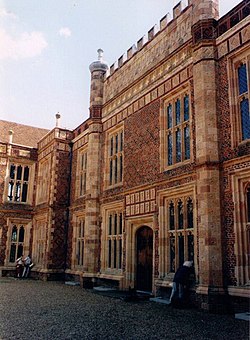 Entrance facade at Sutton Place | |
| Location | |
| Grid reference: | TQ01185354 |
| Location: | 51°16’19"N, -0°33’3"W |
| History | |
| Built c.1525 | |
| For: | Sir Richard Weston |
| Manor house | |
| Information | |
| Owned by: | Alisher Usmanov |
Sutton Place is a Tudor manor house standing with its estate in a loop in the River Wey to the north-east of Burpham in south-western Surrey, and to the south of Woking.
The house is a Grade I listed building.[1]
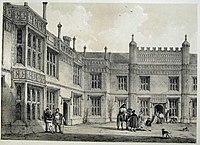
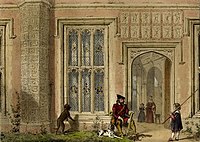
This is a Tudor country house built around 1525[2] by Sir Richard Weston (d. 1541), courtier of Henry VIII. It is of great importance to art history in showing some of the earliest traces of Italianate renaissance design elements in English architecture. In modern times, the estate has had a series of wealthy owners, a trend started by J. Paul Getty, then the world's richest private citizen,[3] who spent the last 17 years of his life there. Its current owner is the Russian billionaire Alisher Usmanov.
A definitive history of the house and manor, first published in 1893, was written by Frederic Harrison (d. 1923), jurist and historian, whose father had acquired the lease in 1874.
Architecture
Historical assessment

Bindoff (1982) stated:
The building, with its perpendicular forms overlaid with Italian ornament, bears little resemblance to any other courtier's house of the 1520s, and it ranks with the vanished Nonsuch Palace as a landmark in the introduction of renaissance ideas"[4]
Harrison (1899) stated it to be "a landmark in the history of art",[5] and "a cinquecento conception in an English gothic frame".[6] He identified it as "one of the first houses built as a peaceful residence, with no thought for defence...one of the first country houses in the modern sense, instead of an imitation castle...Weston perceived that the Wars of the Barons were over, that a gentleman might live at his ease under protection of law and the king's peace".[7]
Weston was certainly daring in his choice of eye-catching decoration above his front-door, for which he surely risked being ridiculed by his manly friends, including the king himself: innocent loving children at play: the amorini. Was this a signal by an avant-gard Sir Richard to his visitors, many of whom must have been valiant and experienced soldiers, that his house was to be a haven where love and play were de rigueur, not the old-fashioned militaristic conversations and behaviours? What a different message this was to that placed above the gates of Dante's Inferno: Lasciate ogne speranza, voi ch'intrate, "Abandon all hope, ye who enter here". At Sutton, the defensive towers and turrets of the old castles and fortified manors have been reduced to mere pilasters, covered with decorative terracotta, caricatures of their former selves, perhaps as symbols of a deliberate rejection of defensive elements by Weston. The symbolism of the short stretch of crenellated parapet on the roofline above the front-door, one of the most potent aspects of the old defensive fortress, has been disarmed and cancelled-out by the almost jarring sight of a covering of yet more playful amorini. A more deliberately dissonant juxtaposition would be hard to imagine, yet that is what Sir Richard ordered to be erected. Sutton is clearly a house with a message to proclaim, which would not have been, could not have been missed by its visitors.
Description

The house is built of red brick and was originally of four blocks enclosing a quadrangle exactly 81 ft. 3 ins. square.[8] The northern block or wing was demolished in 1782, giving the house its present open appearance of a U-shape, the two surviving flanking wings forming a courtyard looking to the east. An unusual feature is that, due to the extreme flatness of the site, the entire ground floor of the whole house stands on the exact level of the soil, so that no step exists for entering the house on any side.[9] It is set within a separately listed formal parkland at the end of a long driveway.
Terracotta elements

The decorative elements made from moulded terracotta on the facade are renaissance italianate. They consist of designs made from 40-50 different moulds,[10] most strikingly comprising a panel of two rows of amorini immediately above the entrance door. Such Italianate influence had never before been seen in English architecture, and is thought to have resulted from designs seen by Weston during his travels on embassies to France, where he might have seen some of the newly built chateaux on the Loire. With very minor exceptions, no stone was used in the building and decoration of Sutton Place, only brick and terracotta.[11] Thus, the bases, doorways, windows, string-courses, labels and other dripstones, parapet, angles, cornices, and finials are all of moulded clay.[10] Such usage is only found in two other contemporary buildings, East Barsham Manor in Norfolk and Layer Marney Tower in Essex. Its use was, however, rapidly abandoned in England, to appear again only in the Victorian era. The terracotta proved very hard-wearing and was described by Harrison in 1899 as "sharp and perfect" in condition.[10] The terracotta has, however, undergone, in the 1980s, a £12 million refurbishment, involving much replacement, by the specialist firm Hathernware Ceramics Ltd, which used 18 different colour blends of clay to match the original variety of shades.[12] Prior to that, it seems the only new elements were from 1875 when 10 new terracotta mullions and window-frames made by Messrs Blashfield of Stamford, from moulds of existing windows, replaced sash-windows inserted in the 18th century. Two completely new small windows were, at the same time, created from terracotta in the gables of the quadrangle.[13]
Other terracotta decorative elements include framed monograms of "R W", the builder, and reliefs of his rebus of the concave-ended barrel, probably signifying a "waisted-tun". The "tun" was a play on the last syllable of Weston. The concave-ended barrel is sometimes shown between two goose heads, the significance of which is unclear, unless it be the French word Oie plus -"tun". Willam Bolton (d.1532), prior of St Bartholomew's in Smithfield, is also known to have used the rebus of a "tun", as can be seen in his surviving oriel window within the church in the form of a barrel with a bolt of a crossbow passing through vertically. Another recurring terracotta element is a double bunch of grapes, thought by some to represent hops. Harrison believes the story of Weston having been "the King's brewer" unfounded and "a vulgar story".[10] Similar hop-like bunches of grapes also feature at Layer Marney, and there is no evidence of Lord Marney, captain of the royal bodyguard, having been similarly a brewer.
Painted glass
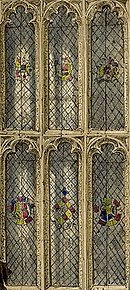
The hall windows contain fine painted glass, much installed contemporaneously with the building of the house. These consist of shields of arms and other rebuses. There are, in total, 14 windows containing 92 separate lights, each containing a shield or quarry of painted glass. They are of different dates and quality, belonging to three separate epochs, but mostly relating to the builder's family. Some glass predates the house and is believed to have come from the earlier manor house of Sutton. Harrison states certain to be "of extraordinary beauty and rarity"..."of the finest painted glass of the time of Henry VIII".[14] Apart from family arms, the arms of King Richard III and emblems of the Roses, Red and White are also shown; all relate to the Battle of Bosworth at which Edmund Weston, Governor of Guernsey, father of Sir Richard, is thought to have assisted Henry Earl of Richmond (later Henry VII, by providing the use of money, ships or even a contingent of soldiers.[15]
History
Sutton Manor, within which the Tudor mansion is situated, appears in the Domesday Book of 1086 as Sudtone. It was held by Robert Malet. Its Domesday assets were: 3 hides; 1 mill worth 5s, 3 ploughs, 20 acres of meadow, woodland worth 25 hogs. It rendered £5. The previous manor house stood about a quarter of a mile from the present house, on the hill now occupied by St Edward's Chapel and Vine Cottage.[16]
Within Sutton Place was once the blood-stained ruff of St Thomas More and a crystal pomegranate that once belonged to Queen Catherine of Aragon. The pomegranate emblem of the Queen features as a decoration in several places within the house, which suggested to Harrison that Weston certainly built the house before she was divorced by Henry VIII in 1533, and possibly before 1527 when it would have been known by his courtiers, such as Weston, that the King had turned his affections away from Catherine towards Anne Boleyn.[17]
St Edward the Confessor Church
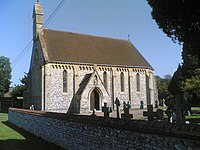
Within the grounds of Sutton Place is St Edward the Confessor Church. It is a Roman Catholic church, built in 1875 in the early English Gothic style and is a Grade II listed building.[18] The architect was Charles Alban Buckler, who is buried in the cemetery that surrounds the church. He also designed a number of outher Roman Catholic churches: St Thomas of Canterbury and English Martyrs in St Leonards-on-Sea, St Peter's Church in Shoreham-by-Sea, St Francis of Assisi's Church in Midhurst, St Richard's Church in Slindon, most of St Dominic's Priory Church in Haverstock Hill, and parts of Arundel Castle.[19]
The church was opened in 1876. Later a reredos designed by Frederick Walters was added, and glass by Hugh Ray Easton.
Sutton Place in fiction
The lives of various owners of Sutton Place through the centuries were fictionalized in the Sutton Place Trilogy by Dinah Lampitt (aka Deryn Lake), comprising the novels Sutton Place (1983), about Richard Weston and his family, The Silver Swan (1984), about Melior Mary Weston, and Fortune's Soldier (1985), about Captain John Joseph Webbe Weston and Lady Horatia Waldegrave.
Outside links
| ("Wikimedia Commons" has material about Sutton Place, Burpham) |
- Hathernware Ceramics Ltd, 1980s terracotta restorer
- Getty at Sutton Place - YouTube
- The Weston estate papers, 1382-1852, in the Surrey Archives:
- part 2 of 2
- Sutton Place including the Service Court Yard
- Entrance Lodge and Gates to Sutton Place - British Listed Buildings
References
- ↑ National Heritage List 1236810: Sutton Place
- ↑ Harrison, F.(1893)
- ↑ Guinness Book of Records, 1966, p. 229
- ↑ Bindoff, S.T. (ed.), History of Parliament: House of Commons 1509-1558, vol 3, Weston, Sir Richard, pp. 590-2
- ↑ Harrison, preface vii
- ↑ Harrison, p. 2
- ↑ Harrison, p. 5
- ↑ Harrison, F, p.171
- ↑ Harrison, F, p.172
- ↑ 10.0 10.1 10.2 10.3 Harrison, pp.161–2
- ↑ Harrison, p.153. Exceptions include stone tops of semi-octagonal turrets flanking the main entrance door (p.162, note 1)
- ↑ Hathernware Ceramics Ltd — terracotta restorer here in the 1980s
- ↑ Harrison, pp.162-3
- ↑ Harrison, pp.200-201
- ↑ Harrison, p.44-5
- ↑ Harrison, p.152
- ↑ Harrison, p.151
- ↑ Church of St Edward the Confessor, Sutton Green - British Listed Buildings
- ↑ Sutton Park - St Edward the Confessor from English Heritage, retrieved 11 February 2015
- Harrison, Frederic. Annals of an Old Manor House: Sutton Place, Guildford. London, 1899 (The author's family held the lease of Sutton Place and resided there from 1874 to post 1899)archive.org on-line text
- Woking parish, Sutton Manor, pp.381-390 - A History of the County of Surrey - Volume 3 : {{{2}}} (Victoria County History)
- Sutton Place, notes by Philip Arnold
- The Weston Chapel, www.holytrinityguildford.org.uk
- Sutton Place & St Edward's Church, notes by Jim Miller, 2002
Further reading
- Willis, Dr. David & Albion, Rev. Gordon. St. Edward's, Sutton Park, Guildford: A Guide to the Church & its Treasures, c.1972.
- Taylor, Brian: 'The Catholics of Sutton Park'
- Aubrey, John: 'Natural History & Antiquities of the County of Surrey'; Volume 3, page 228
- Manning, Owen: 'History and Antiquities of the County of Surrey, with a facsimile Copy of Domesday, Engraved on Thirteen Plates', Volume 1 (1804,9,14) page 136 et.seq.
